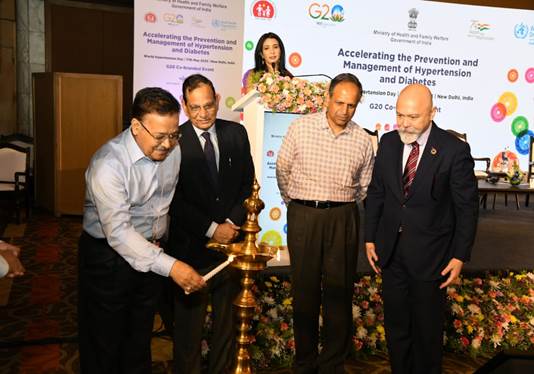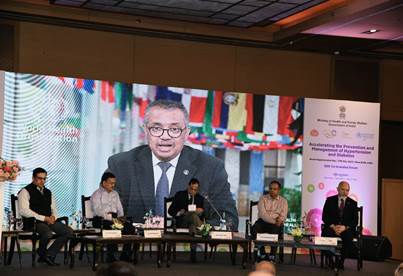
New Delhi: The Union Health Ministry launched an ambitious initiative of screening and putting 75 million people with hypertension and diabetes on Standard Care by 2025, to mark World Hypertension Day, here today.
This was announced at the G20 co-branded event “Accelerating the Prevention and Management of Hypertension and Diabetes”, organized by the Union Health Ministry and the World Health Organization (WHO) by Dr V K Paul, Member (Health), NITI Aayog in the presence of Rajesh Bhushan, Union Health Secretary. Dr Tedros Adhanom Ghebreyesus, Director General of WHO virtually addressed the event.

Congratulating India on this initiative, Dr Tedros Adhanom Ghebreyesus said that the “Indian Government’s ambitious target of reaching 75 million people with Hypertension under standard care in primary healthcare by 2025 is the largest cover of NCDs in the world for primary healthcare”.
Highlighting the innovative scheme, Dr Paul stated that this will be the largest expansion of Non-Communicable Diseases (NCDs) in primary healthcare programmes in the world with a community-based approach starting at the primary healthcare level. “India is making efforts to achieve results in social indicators like life expectancy, maternal mortality rate, and NCDs at par with developed nations,” he stressed.
The Outcome Budget document of Union Budget 2023-2024 has for the first time introduced hypertension and diabetes treatment as output indicators reflecting reflects the government’s commitment to scale-up hypertension and diabetes coverage services.
Dr Paul mentioned that the battle against NCDs has to be fought through the primary healthcare level and pointed out that India has created a platform to fight the menace through the creation of more than 1.5 lakh Health and Wellness Centres (HWCs) and the operationalisation of telemedicine and digital health services.
To accelerate the prevention and management of Hypertension, Dr Paul urged State teams to adhere to all Standard Operating Procedures (SOPs) especially the screening SOPs correctly at the grassroots since screening is the bedrock of successful management of any disease. However, he noted that only screening is not enough. Detection should lead to outcomes. He, therefore, urged all stakeholders to ensure that at least 80% of the diagnosed people are under treatment. The need for private sector engagement in this effort and the contribution of the academic and research sectors in creating models and different building blocks for achieving the ambitious targets were also emphasized.
He also emphasized that greater effort should be put into prevention which includes lifestyle changes through eating good food, exercising and other wellness practices. He highlighted the need for Jan Andolan to make this effort more visible through community participation; and the need for countries to work together and share each other’s successes in the spirit of “One Earth, One Health”.
Union Health Secretary, Rajesh Bhushan highlighted the interplay between economy, societal forces and epidemiological forces. He stated that with over 7% economic growth in the last two decades, the average life expectancy of people in India has risen significantly to around 70 today.
“Lifestyle of a large section of the population has become more sedentary than before,” he said and noted that the solution to the problem of NCDs lies in a societal approach where awareness, prevention, health promotion and wellness are looked at in an integrated manner. He also stressed “on the need for inter-sectoral efforts and collaboration of public and private sectors to address the growing burden of NCDs in the country”.
– global bihari bureau





